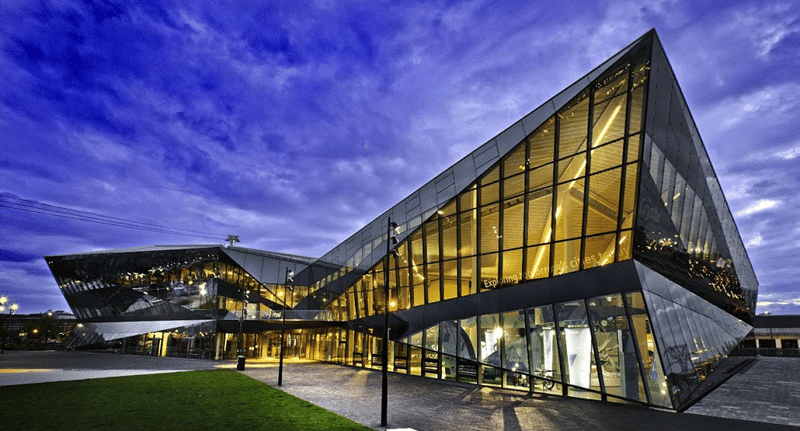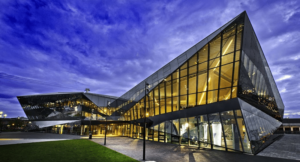“Smart buildings are more than just the technologies they use.
The goal is to extend the human capacity to create ideas, visions, and inventions.”
Prof. Derek Clements-croome.
Architecture reinvents itself constantly to make people’s daily lives easier and better. Use of technology plays a crucial role in this endeavor. The concept of “smart buildings” has revolutionized architecture in recent years. Smart buildings integrate technology and the Internet of Things (IoT) to provide solutions to age-old issues, reducing costs and improving efficiency. Let’s first briefly look at some of the benefits smart buildings bring:
- Reduce energy consumption
- Improve building efficiency
- Predictive maintenance
- Increased productivity
- Better use of resources
In this series, we shall discuss the main highlights of some of the finest modern smart buildings across the globe, so, here we go!
The Crystal, located in London’s Royal Docks, is one of the finest examples of modern sustainable architecture. Designed by WilkinsonEyre Architects and completed in 2012, this iconic building showcases a multitude of smart technologies aimed at creating a self-sufficient and environmentally friendly atmosphere. Spanning two floors with a total floor area of approximately 6300 square meters, the Crystal stands as a testament to innovative design and sustainable living.
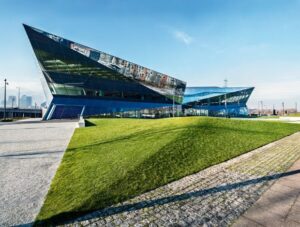
SMART TECHNOLOGIES UTILIZED:
- Advanced building management system (BMS)
The Crystal employs an advanced building management system (BMS) that integrates all the building’s systems, including heating, ventilation, air conditioning, lighting, and security. This system ensures optimal energy use by adjusting settings in real-time based on occupancy and weather conditions. The BMS contributes significantly to energy efficiency and reduces operational costs.
- Renewable energy sources
The building harnesses renewable energy through a combination of photovoltaic panels and ground source heat pumps. The photovoltaic panels installed on the roof generate electricity from sunlight, while the ground source heat pumps extract heat from the earth to provide heating and cooling. These technologies reduce reliance on fossil fuels and lower the building’s carbon footprint.
- Water conservation systems
Water conservation is a key focus at the Crystal. The building features rainwater harvesting systems that collect and store rainwater for use in toilets and irrigation. Additionally, water-efficient fixtures and fittings minimize water usage. These measures contribute to a significant reduction in water consumption, promoting sustainability.
- Intelligent lighting systems
The Crystal is equipped with intelligent lighting systems that use LED technology and motion sensors. These systems adjust lighting levels based on occupancy and natural light availability, ensuring energy is not wasted. The use of LEDs also reduces energy consumption and extends the lifespan of light fixtures.
- Sustainable building materials
The construction of the Crystal utilizes sustainable building materials, including recycled steel and low-emission glass. These materials reduce the environmental impact of construction and enhance the building’s insulation, contributing to energy efficiency.
BENEFITS OF THE ABOVE SMART TECHNOLOGIES:
- Energy efficiency and cost savings
The integration of smart technologies at the Crystal has resulted in significant energy savings. The use of renewable energy sources and efficient systems reduces the building’s overall energy consumption. This lowers operational costs, and in addition, minimizes building’s environmental impact.
- Reduced carbon footprint
By relying on renewable energy and sustainable materials, the Crystal significantly reduces its carbon footprint. The building’s design and technologies align with global efforts to combat climate change and promote sustainability.
- Water conservation
The water conservation systems in place ensure that the Crystal uses water efficiently. This reduces the building’s demand on local water supply and promotes responsible water use, which is particularly important in the urban areas facing water scarcity.
- Enhanced comfort and convenience
Smart technologies improve the daily lives who work in or visit the Crystal. The advanced BMS maintains a comfortable indoor environment by adjusting heating, cooling, and lighting based on real-time conditions. This creates a pleasant atmosphere and enhances productivity.
- Long-term sustainability
The use of sustainable materials and renewable energy sources ensures that the Crystal remains environmentally friendly over the long term. This forward-thinking approach sets a benchmark for future developments and demonstrates the feasibility of sustainable urban design.
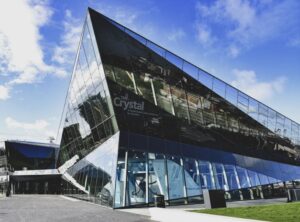
IMPACT ON DAILY LIFE
- Healthier indoor environment
The Crystal’s intelligent systems ensure a healthy indoor environment by maintaining optimal air quality and temperature. This is achieved through efficient ventilation and air filtration systems that remove pollutants and allergens, contributing to the well-being of occupants.
- Convenience and efficiency
The smart technologies at the Crystal make daily operations more efficient. Automated systems reduce the need for manual intervention, allowing staff to focus on more critical tasks. The convenience of automated lighting and climate control also enhances the user experience.
- Educational opportunities
The Crystal serves as a living example of sustainable architecture, providing educational opportunities for visitors. The building hosts exhibitions and tours that showcase its technologies and design principles, raising awareness about sustainability and inspiring future innovations.
The Crystal in London exemplifies the integration of smart technologies and sustainable design in modern architecture. By utilizing advanced systems for energy management, water conservation, and lighting, the building achieves impressive levels of self-sufficiency and sustainability.
We will continue to bring some terrific smart buildings that are showing the way for the development of future smart cities and urban centers. Don’t miss the fun!
Keywords:
- Smart buildings.
- Smart technologies.
- Carbon footprint.
- Water conservation.
- Rainwater harvesting.
- Energy efficiency.
- Intelligent lighting systems.
Sources:
https://www.inawe.in › uploads › 2015/12 › The…
https://www.slideshare.net › Education
https://gbplusamag.com › the-crystal
https://earthtimes.org › blogs › green-opinions › the-crys…
https://eventcomm.com/projects/the-crystal-a-sustainable-cities-initiative-by-siemens
https://www.onofficemagazine.com/architecture/the-crystal-by-wilkinson-eyr
ABOUT THE AUTHOR
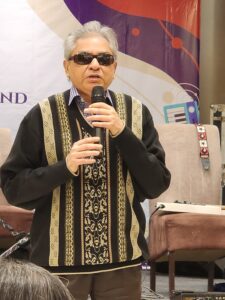
Sandeep Singh is an architect from IIT Roorkee.
Ten years after graduating, he lost his vision to genetic Diabetes.
He reinvented his career and turned writer.
He has authored two fiction books and writes blogs on
Architecture, Outsourcing, Safety and a variety of other
subjects for different organizations. He also chairs and runs two NGOs

